
A Cave of Candles / by Dorothy V. Corson

Chapter 15
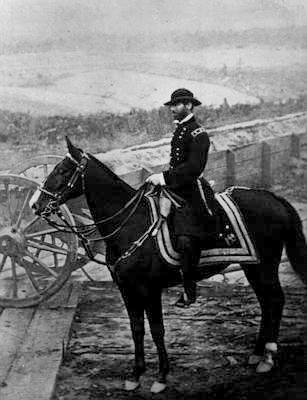
General Sherman's Family Ties to Notre Dame & St. Mary's
With my research on St. Angela's Island completed, I still had a few days to spare before the University Archives reopened. I decided to check one other source -- more books on St. Mary's history -- at the Convent Library. I wanted to be sure I hadn't missed anything of additional interest on either the St. Mary's early Grotto or St. Angela's Island before moving on.
Sister Paulette, in charge of the convent library, generously offered to share with me any books they had which might be of help. I began by checking out the oldest ones I could find going back to the early 1800s, not knowing, that in doing so, more unexpected pieces were about to be added to my research.
When the name Ewing -- the signature on the top of the earlier mentioned 1859 guide book -- turned up in my reading again it immediately sparked my interest. I wondered if Ewing Avenue in South Bend had been named after this Ewing family. Then I learned that Ellen Ewing Sherman and Mother Angela's family, the Gillespies, were related and that members of all three families had gone to both schools. Ellen Ewing was the wife of General William Tecumseh Sherman. She lived in South Bend while her children went to Notre Dame and St. Mary's during the Civil War. It was not an uncommon practice at the time for families, most especially southern ones, to send their children to Notre Dame and St. Mary's to keep them safe during the war. It was reason enough for South Bend to have avenues named Ewing and Sherman.
General Sherman was orphaned as a boy and was raised by the Ewing family. He married, Ellen, one of his adopted father's daughters. Their two oldest, Minnie and Willy, were the first of their children to attend Notre Dame and St. Mary's during the war years. Willy spent his eighth year as a student at Notre Dame while his older sister Minnie attended St. Mary's. The sexton told me he had heard the story that General Sherman's son was buried at Cedar Grove Cemetery adjacent to the campus. He said a search through the cemetery records for evidence to confirm the story, revealed that a fire had destroyed many early grave records. I wondered about it at the time. Reading more about the Ewings and Shermans in these early histories of St. Mary's, rekindled my interest in this particular undocumented story. It also reaffirmed my decision to take the extra days to do a little more serious reading before concluding my St. Mary's research. In doing so, I found the evidence I needed to document the story.
After the fall of Vicksburg, when the Sherman children returned home to Ohio for a vacation, Ellen took Willy and the rest of the children to visit Sherman's encampment on the Big Black, below Vicksburg, during a respite in the battles. They spent six weeks at the camp. Willy, their first born, was taken violently ill with camp fever on the day they left Vicksburg by steamer for home. On the fifth day, upon reaching Memphis, he was taken from the boat to the Gayoso House, where he died the following evening, October 3, 1863. He was nine years old.
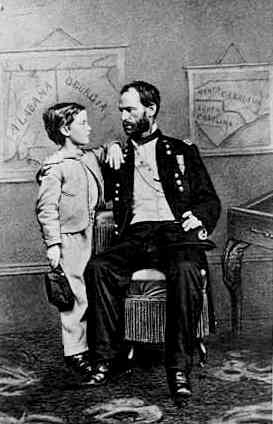
This information verified his death but not where he was buried. I knew Notre Dame had a large collection of Sherman papers which contained extensive correspondence between Ellen and her husband throughout the trying times of the war. The untimely death of their first-born son must have been mentioned in them. I decided to supplement my study of St. Mary's early history with a search through the Sherman papers as soon as the University Archives reopened.
After many hours, and several days, spent pouring over the correspondence between Ellen and "Cump," as she called the General, I found the evidence I was seeking. Willy was buried in Lancaster, Ohio, the Ewing's hometown, not Cedar Grove Cemetery. His death was recorded in the ledger of Notre Dame Death Notices kept for that period by the school, but it did not indicate the fact that he was buried in Ohio. I'd been thrown a curve, but very soon, it straightened itself out. I also stumbled upon the reason the rumor was so strong that Sherman's son was buried in Cedar Grove.
In January, four months after Willy's death, another son, Charley, was born to the Shermans. Ellen's grief over Willy's death was intensified by the fact that he had been away from her during the school year. It was very evident in her letters that she suffered deeply from not having seen him for many months. After his death, she decided to move to South Bend, taking her new baby with her, so she could be near her other children while they attended both schools. She made arrangements to live at the Schuyler Colfax home in the city. Schuyler Colfax came to South Bend in 1836 and was later Vice-President of the United States from 1869-1873.
When she and the children returned to South Bend in September of 1864, she obtained a rose bush from the Notre Dame grounds and a box of pebbles which she had the children gather from the river bank at St. Mary's where Willy often played. She planned to put them on his grave in Lancaster.
Charley, Ellen's healthy baby boy had contracted a cold in Lancaster. It was felt a change of climate might be good for him. However, his condition worsened after they arrived in South Bend. On December 4, 1864, a year and two months after Willy's death, 10 month old Charley died in Ellen's arms. Anna McAllister describes his burial in her book, Ellen Ewing, Wife of General Sherman:
Sister Angela asked Ellen to be allowed to take the body to St. Mary's Academy. Here the children of Mary kept constant watch beside the casket until Wednesday afternoon when Father Sorin performed the beautiful and touching rites of infant burial in the Church of Sacred Heart at Notre Dame.(173)
The General was on the march, engaged in hazardous maneuvers through enemy country when the little baby he never saw died. The poignancy of these two deaths is described in Katherine Burton's, Three Generations:
Cump was not there, He did not even know the baby was dead. Charley was ten months old when he died and his father had never seen him. For several months Ellen had heard nothing from him.
The Shermans moved to St. Louis in 1865, where in later years General Sherman was buried. Katherine Burton records the following information regarding Charley and Willy's reburial in St. Louis in 1866:
Sherman acquired a family lot in Calvary Cemetery in St. Louis so that Willy and Charley could be buried there. . . . On a trip to Washington the General stopped at Lancaster to get Willy's coffin. . . . He had already written to Father Sorin at Notre Dame asking him to help with the removal of Charley's coffin.(174)
So, it was not General Sherman's son Willie who was buried at Cedar Grove. It was his infant son, Charlie -- the son he never knew -- whose first grave was at Cedar Grove Cemetery at Notre Dame.
Much has been written about the proud and tough General William Tecumseh Sherman, but a little item in a 1874 Scholastic, "The General at a Circus" tells another side of his personality:
Sitting in front of us was General Sherman and with him quite a number of children whom he had gathered up from the 'by-ways and hedges.' We saw him look down under the seat, and then haul out a dirty, ragged little darkey, who had crept in under the tent, and then seat him at his feet, where, by crowding, was made a place for the little rascal. 'Now,' said the General, 'sit there, my boy, and see everything. Bless me! many is the time I've done just the same thing, and many a thrashing have I had.' Sherman seemed like a child; everything pleased him, and we wondered where was the vanity of which people talked so loudly. Who has a better right to be proud than Sherman; proud of his valor, proud of his deeds, proud of his wife, proud of his children, and proud of the love of his countrypeople? When he went to Europe he did not go via London, but took the far-off countries to the East, and made London the tail-end rather than head of his journey. Why? 'Because,' to use his words as nearly as we can, 'I had never been to Europe, and if I had gone to London, I'd have found myself pretty ignorant of their entertainments from want of observation of their part of the world. So I did it all up at the other end, and knew as much as any fellow when I got to London.(175)
I learned more about the Ewings, Sherman's and Gillespies and their family ties with Notre Dame and St. Mary's as I went along. This more recent information also explained the Master Thomas Ewing signature I'd found earlier in the 1859 guide book. Thomas Ewing, a nephew of Ellen Ewing, was a student at Notre Dame when he penned his name on the top of the 1859 guide. Later, when Willy arrived at Notre Dame, they were playmates on the campus. Because his sister was at St. Mary's, Willy Sherman spent much of his time there. He spent his last Christmas with his Aunt Mary Phelan, Sister Angela Gillespie's mother, who resided in a cottage at St. Mary's.
When Mother Angela's father died, her mother remarried a Mr. Phelan who offered his large farm in Ohio to Father Sorin in exchange for an annuity and a home for them at St. Mary's. The Phelans were among the earliest benefactors of Notre Dame and St. Mary's. The little cottage they lived in was said to have been a blacksmith's shop, for which the Sisters paid $5. It was fixed up as a home for the Phelans and moved from Bertrand to St. Mary's at Notre Dame along with another building. Much of the early landscaping and tree planting at St. Mary's was done by Mother Angela and her stepfather, some beautiful willow trees among them.
It is still a tree in evidence on the campus. Especially at Marian Lake in front of the old Saint Mary's College Library, now known as Haggar College Center. More recently planted willows grace the artificial lake in several areas. Marian Lake was created in 1907 to enhance the college grounds. There is a tiny island in the center with a bridge leading to it which has a beautiful detailed statue of Mary in the center of it. Canadian geese are often seen there in great numbers and goldfish of all sizes swim in its waters.
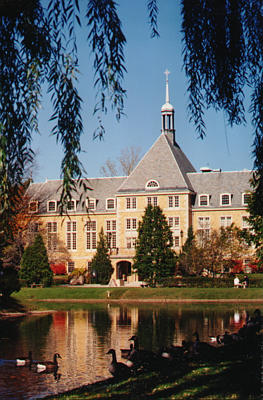
Eugene O'Neill's stage play, Long Day's Journey Into Night, for which he received the Nobel prize after his death, was written in 1940. In the quotes excerpted about his mother and St. Angela's Island, mentioned earlier, he refers to the island being in a lake rather than a river. Since St. Angela's island in the river would have been long forgotten, and his mother being gone, he might, mistakenly, have thought or been told when he was writing his script, that it was the island in Marian Lake. It would have been an easy error to make under the circumstances, since both had statues of Mary.
In Mrs. Post's earlier mentioned "Gleanings," I found this unusual story about the area before it became Marian Lake. Under the heading, "Interesting Facts of Clay Township" she relates:
The first cemetery in Clay township was located where Lake Marian was dug at St. Mary's College. The remains of three bodies were uncovered when the area was excavated. The remains were re-buried in St. Mary's Community Cemetery. One was a man, another a girl possibly 18 years old with beautiful teeth and black hair and the bones of an infant. The McCombs genealogy states that Ruth and John and their child died and were buried in this little cemetery. They were children of the first Lambert McCombs in Clay Township.
A good portion of the land which is now owned by St. Mary College was formerly owned by the McCombs Family.
Another beautiful willow tree stands in a field south of the new, Inn at St. Mary's, and yet another until recently was behind Bertrand Hall near the Church. I often admired it on my visits to the convent over the past 15 years. Like Notre Dame, St. Mary's is steeped in early history. I found this charming story while paging through the June 1913 issue of The Chimes, St. Mary's student magazine. It is also more evidence of how intertwined the Gillespie, Ewing and Sherman families have been with the Notre Dame and St. Mary's campuses:
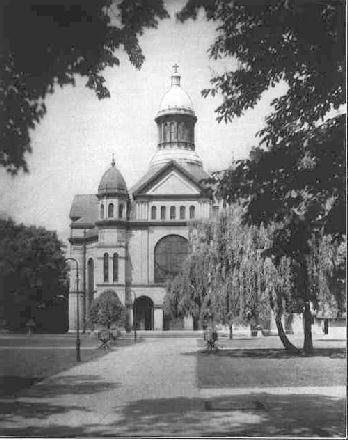
A Treasured Landmark
More than 100 years ago a willow slip was planted and grew in the town of Lancaster, Ohio. It was planted at the doorstep of her home by a young bride who had carried it as a riding-whip, for she had traveled horseback from her father's house in Western, Pennsylvania as a bride. It grew into a noble tree. Thirty or forty years later, a slip from it was planted beside the grave of another daughter who had come from Pennsylvania as a bride. From that tree, at the request of Mother Angela, a slip was cut and sent to her. Those brides, Anna and Eleanor Gillespie, were the great-grand aunts of our beloved foundress, Mother Angela, and that self-same slip, now a magnificent tree, is the pride and beauty of St. Mary's.(176)
It is signed by Mrs. Ella Ewing Brown, Class of 1870 (Great-granddaughter of the 2nd bride).
Ellen Ewing was a granddaughter of the same bride. Ella Brown was Ellen's niece, the daughter of her brother Philemon Ewing. This magnificent tree, pictured in the article, stood in front of the Church of Loretto on the St. Mary's campus. I had seen this same beautiful weeping willow in early pictures of the church, but never knew the story behind it until I happened upon this article from The Chimes in one of my visits to the college archives.
Judging by the 1913 date it appeared in The Chimes, the original 100 year old tree the slip was taken from in Lancaster, Ohio, must have been planted in front of the brides home in 1813. The slip sent to Mother Angela might have been planted by her sometime after the mid 1850s making it a fairly old tree, for a willow, in the picture taken of it in 1913.
Words under a picture of Lake Marian in a 1935 Courier produced more information about the willows on campus. "This tree growing beside Lake Marian is a lineal descendent of the willow tree brought to St. Mary's by Mother Angela from her girlhood home in Lancaster, Ohio. Mother always took pride in the fact that the Lancaster tree, in turn, had been brought to Ohio by her parents from Washington's estate on the Potomac."
The unique religious significance of the willow tree surfaced in my reading about this time. One book in particular on cemetery sculpture and monuments called Soul In The Stone was fascinating reading. It covered the symbolism of angels, a familiar figure in cemeteries, and other shapes, how ivy depicted remembrance and the dove faith. This excerpt, explains the significance of the candle and the willow tree:
The butterfly and the candle are symbols of the human soul; the owl as the messenger; the fern and the anchor, indicating hope; the lily purity; and the rose love. Angels are used in all Christian cemeteries, as emissaries between heaven and earth. They provide us with a quasi-human personage who helps us make the transmission into incomprehensible eternity. Among Christians, the willow tree symbolizes the Christian faith, which, like the willow can thrive anywhere on earth. It also implies sorrow with its shape and its popular nickname, weeping willow.
This description of the setting of a cemetery being a place of rest and quiet could have been written about the peace and tranquillity of the pastoral surroundings to be found at St. Mary's and Notre Dame, as in this scenic view of St. Mary's Lake at Notre Dame:
It seems a place removed from time where nature flourishes and the past mingles with the present, encouraging reflection and wisdom as it tunes out the frantic and dubious daily 'achievements' of life at the end of the twentieth century. It is a place that can shelter lovers and thinkers and its silence gives meaning to the sounds of life. Best of all in an age of bewildering changes [the beauty of nature] is always the same.(177)
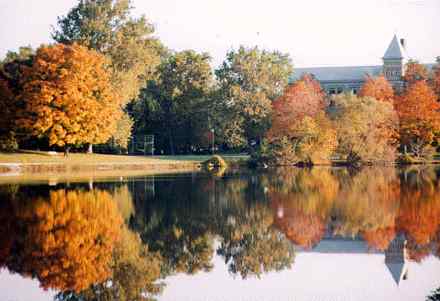
It's possible the weeping willow I have admired over the past fifteen years, which was to the right of the front of the church behind Bertrand Hall, might have been another son or daughter of this landmark tree. The Sisters remember it well and said it was injured when struck by lightning a year or so ago when construction was going on in the convent area. Because they felt it might deteriorate and fall on construction workers, it was removed shortly afterward.
A check with the convent groundskeeper revealed that a survey taken before it was removed recorded its 47 inch diameter, which is a good size tree. He confirmed that it was not the Landmark Tree. He said the willow in front of the church was replaced with a pin oak tree during St. Mary's centenary in 1943. It is there today and is quite a large tree. We both speculated that perhaps the one behind Bertrand Hall might have been a slip from the one removed -- perhaps a third generation planting. If so, it is unfortunate that another slip was not taken from it, and planted, before it was removed a year ago. How nice it would have been to perpetuate this historic landmark tree -- this symbol of Christian faith -- into its fourth or fifth generation.
Ah, if old trees could talk, just imagine the stories they could tell of the early days on campus.